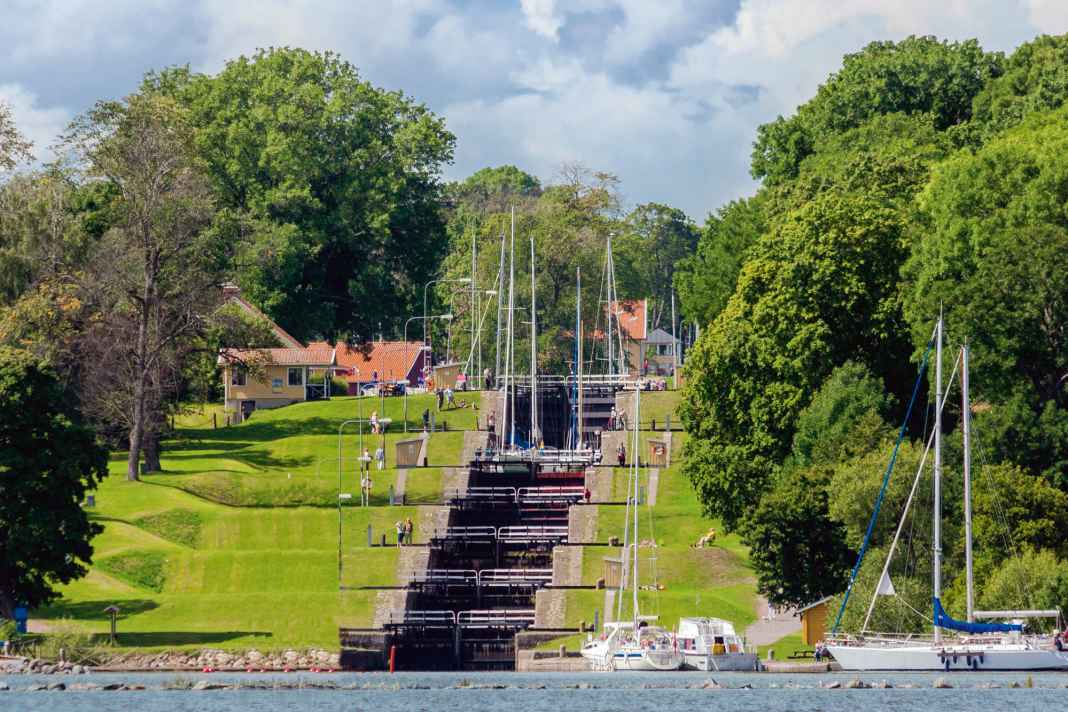




By their very nature, rivers are in most cases anything but convenient and safe transport routes: rapids, waterfalls, shallows, narrow bends with fast currents - the list of dangers and obstacles that made life difficult for boatmen in earlier times was long. Added to this were variable and unreliable water levels with floods and periods of drought.
People therefore began to "tame" the rivers with weirs. Their bed no longer led down into the valley like an undulating chute through which the water shot, but resembled an even staircase. Between the individual steps, in the so-called dams, the gradient and flow velocity were much lower than before. Ships and rafts travelling downstream could now be kept under control more easily, and towing uphill, when muscle power had to be used to pull from the bank, was at least a little less arduous.
Chamber locks for shipping from the late Middle Ages onwards
From the late Middle Ages, chamber locks made the barrages passable for shipping. Leonardo da Vinci was also involved in their development. The simple functional principle has hardly changed to this day: In the chamber, which is closed on both sides with gates, the water level can be changed at will by inflow and outflow. A vehicle in the chamber rises or falls with the water level.
The structure and function of modern locks are explained in detail in this lock special. The invention of the lock also made it possible to build canals that connected other waterways - even if a gradient or a higher watershed had to be overcome. This was first achieved in 1398 with the opening of the "Stecknitzfahrt", which connected the Elbe with the then powerful Hanseatic city of Lübeck in order to better transport the Lüneburg salt to the Baltic Sea. 17 locks were built, one of which has been preserved: the Palm Lock near Lauenburg. Incidentally, the modern successor to the Stecknitz canal is the Elbe-Lübeck Canal.
With the expansion of the canal and river network, the demands on the locks also increased: initially made of wood, brick, stone and finally concrete were soon used. On waterways with large volumes of traffic, the number of vehicles continues to grow to this day, necessitating ever larger hydraulic structures. The differences can be enormous, from small, hand-operated barge locks to large shipping locks with a usable chamber length of well over 200 metres that can accommodate entire convoys.
These lock types are available
There is now a whole range of specialised types of lock: Sea locks, for example, seal off harbour basins in tidal waters. Economical locks are used on canals. They "consume" less water thanks to a sophisticated system of retention basins. Shaft locks, lock stairs and ship lifts, on the other hand, overcome particularly high heads. If a barrage has two parallel chambers that can be operated alternately, it is referred to as a double-chamber lock. Sometimes there is even a special, smaller lock for pleasure craft. In areas with little commercial shipping and increasing boat tourism, there has been a clear trend in recent years towards semi-automatic self-service locks that can be conveniently operated from on board.
Background story: Leonardo da Vinci and the lock

The oldest form of lock gate is the stem gate. It is so called because its closed wings "stem" at an angle against the pressure direction of the water - i.e. upstream. The principle is ingeniously simple and safe at the same time: this arrangement means that the gate can only be opened when the water level is equalised on both sides. Until then, the water presses the two wings together and makes the gate watertight. To allow water to flow through the closed gate, the contactors in its lower section must be opened using push bars. Leonardo da Vinci is considered to be one of the fathers of the stem gate; it is not certain whether he actually invented it around 1500, but his drawing is the oldest known today.
In addition to the classic stem gate, there is now a whole range of other gate types. Larger locks in inland areas can also be equipped with lifting, lowering, folding and sliding gates (which open to the side), depending on the design and structural conditions on site. The subsoil and the drop height to be overcome play an important role in the decision in favour of a special technology. Sea locks that are also exposed to changing tides, on the other hand, often have double gates or are sealed off with semi-circular sector gates.

